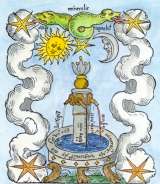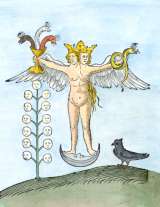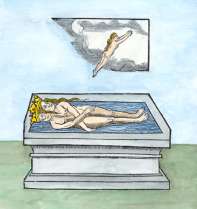Directed study
Sunday, February 13, 2005
The Rosarium - The Hierosgamos in the History of Religions
The Hierosgamos Theme in the Images of the Rosarium Philosophorum
by Karen-Claire Voss
Both the texts and the iconography of the alchemical tradition of the sixteenth and seventeenth centuries are filled with allusions to ‘the chymical marriage,’ [1] and some of the most beautiful and compelling images in the texts depict the conjunction of opposites as a royal marriage. [2] These descriptions and images occur with sufficient frequency to warrant comparison with the hierosgamos (sacred marriage), as understood in the discipline of history of religions.
The present analysis makes use of examples from the Rosarium philosophorum, first published in 1550, [3] which contains a number of memorable pictorial images of two lovers embracing. The very title of this text turns out to point us in the right direction, for in the light of the history of religions, the word rosarium (‘rosary,’ in English) immediately evokes a cluster of symbols which are all associated with the hierosgamos theme – for example, the enclosed garden of the Virgin Mary and the taming of the unicorn by the virgin. [4] Thanks to the title of this work, we encounter the idea of the hierosgamos even before we embark on a hermeneutical discussion of the images that the work contains.
The Hierosgamos in the History of Religions
The term hierosgamos is used generally to refer to the union between two divinities, or between a human being and a god or goddess, or between two human beings (under certain special conditions); more particularly, it is used to refer to the ritualized, public sexual union between the king and a hierodule (‘sacred prostitute’) in ancient Mesopotamia. [5] This union was accompanied by the belief that the human partners became divine by virtue of their participation in it. It was thought, for example, that the priestess who took part in this ritual became the goddess Inanna in the same way as ordinary bread and wine are thought to become the body and blood of Jesus Christ in the Roman Catholic celebration of the Eucharist. Both ritual forms entail regeneration and transformation; in Mesopotamia, the hierosgamos was thought to insure the well-being of the king, the prosperity of the people, and the continued fertility of the land. [6]
The belief that human beings could participate in the ontological condition of divinity through sexual union, through the body, is exceedingly ancient, but the hierosgamos is not merely an important element in an archaic religious tradition. It is also exceedingly persistent And, in my view, its persistence indicates more than a merely superficial connection between its manifestations in the ancient Near East and in the West; it has become associated with a spectrum of symbolic meanings so rich and compelling that they continue to reassert themselves over and over again. Although the hierosgamos did not find its way into the official teachings of Christianity, for example, it is present nonetheless in the symbolism of Mary as the Bride of Christ. [7]
The major difference between the significance of the hierosgamos in the ancient Near East and the Christian West is that its expression in the former context was bound up with an explicit, embodied praxis that necessitated ritual sexual union. This gives rise to certain hermeneutical difficulties. Scholars of religion sometimes deny or ignore the presence of the hierosgamos idea, or pronounce its use as a conceptual category invalid. [8] Even those who do recognize its presence may yield to the prevailing wisdom that encourages the substitution of a part for the whole, and thus interpret the hierosgamos according to an allegedly higher, spiritualized ideal, having nothing to do with the body. [9] Analogous interpretations are offered for the hierosgamos theme in alchemical texts. Yet, many of the alchemists appear to have undergone a complex experience involving mutual reciprocity between the events in the laboratory and within themselves of a kind that harkens back to, and carries forward, the imprint of a religious tradition that combined physical and spiritual levels of transformation. [10]
It seems to me that there is a core of meanings associated with the hierosgamos that have persisted cross-culturally. If anything, the symbolism became enriched by the addition of Christian doctrines, especially that of the Incarnation, which signified the union of human and divine. I note too the fact that many alchemical texts like the Rosarium insist on the interrelatedness of body and spirit. It would appear therefore that in seeking the ‘conjunction of opposites’ the alchemists were attempting to overturn the conventional conceptual dichotomization between spirit and body, and to offer in its place models that reflected their intuitions of ontological wholeness. Therefore, when interpreting the hierosgamos theme in the context of the alchemical tradition we should keep in mind the fact that it is generally meant to include the body; it signifies not only idealiter but also realiter. [11] An adequate hermeneutics of alchemical iconography can do justice to the multivalence of the hierosgamos images in texts like the Rosarium only by seeking to encompass the totality of their symbolic meanings.
It is not surprising that the author of the Rosarium Philosophorum chose images of the hierosgamos to help convey something of the exquisitely subtle reciprocity invoked in the alchemical coniunctio. The hierosgamos images of alchemy are profoundly eloquent expressions of the experience of the true adepts as they moved through the later stages of the work. For those alchemists, all the elements of ordinary experience were sacralized. The Philosopher’s Stone could be found everywhere; it was ‘walked on, children play with it’; it is familiar to all (people) both young and old, is found in the country, in the village, in the town. [20]
Perhaps we are still capable of learning from the alchemists that what transforms common substance, that which is familiar to all, is no more – and no less – than a deeper apprehension of the significance of the Hermetic motto: ‘What is above is just as what is below.’ This motto, so often quoted and equally often misunderstood, requires that we understand the radical implications of a ‘whole from which nothing is excluded.’ [21]
All images below are linked with extensive commentary.
by Karen-Claire Voss
Both the texts and the iconography of the alchemical tradition of the sixteenth and seventeenth centuries are filled with allusions to ‘the chymical marriage,’ [1] and some of the most beautiful and compelling images in the texts depict the conjunction of opposites as a royal marriage. [2] These descriptions and images occur with sufficient frequency to warrant comparison with the hierosgamos (sacred marriage), as understood in the discipline of history of religions.
The present analysis makes use of examples from the Rosarium philosophorum, first published in 1550, [3] which contains a number of memorable pictorial images of two lovers embracing. The very title of this text turns out to point us in the right direction, for in the light of the history of religions, the word rosarium (‘rosary,’ in English) immediately evokes a cluster of symbols which are all associated with the hierosgamos theme – for example, the enclosed garden of the Virgin Mary and the taming of the unicorn by the virgin. [4] Thanks to the title of this work, we encounter the idea of the hierosgamos even before we embark on a hermeneutical discussion of the images that the work contains.
The Hierosgamos in the History of Religions
The term hierosgamos is used generally to refer to the union between two divinities, or between a human being and a god or goddess, or between two human beings (under certain special conditions); more particularly, it is used to refer to the ritualized, public sexual union between the king and a hierodule (‘sacred prostitute’) in ancient Mesopotamia. [5] This union was accompanied by the belief that the human partners became divine by virtue of their participation in it. It was thought, for example, that the priestess who took part in this ritual became the goddess Inanna in the same way as ordinary bread and wine are thought to become the body and blood of Jesus Christ in the Roman Catholic celebration of the Eucharist. Both ritual forms entail regeneration and transformation; in Mesopotamia, the hierosgamos was thought to insure the well-being of the king, the prosperity of the people, and the continued fertility of the land. [6]
The belief that human beings could participate in the ontological condition of divinity through sexual union, through the body, is exceedingly ancient, but the hierosgamos is not merely an important element in an archaic religious tradition. It is also exceedingly persistent And, in my view, its persistence indicates more than a merely superficial connection between its manifestations in the ancient Near East and in the West; it has become associated with a spectrum of symbolic meanings so rich and compelling that they continue to reassert themselves over and over again. Although the hierosgamos did not find its way into the official teachings of Christianity, for example, it is present nonetheless in the symbolism of Mary as the Bride of Christ. [7]
The major difference between the significance of the hierosgamos in the ancient Near East and the Christian West is that its expression in the former context was bound up with an explicit, embodied praxis that necessitated ritual sexual union. This gives rise to certain hermeneutical difficulties. Scholars of religion sometimes deny or ignore the presence of the hierosgamos idea, or pronounce its use as a conceptual category invalid. [8] Even those who do recognize its presence may yield to the prevailing wisdom that encourages the substitution of a part for the whole, and thus interpret the hierosgamos according to an allegedly higher, spiritualized ideal, having nothing to do with the body. [9] Analogous interpretations are offered for the hierosgamos theme in alchemical texts. Yet, many of the alchemists appear to have undergone a complex experience involving mutual reciprocity between the events in the laboratory and within themselves of a kind that harkens back to, and carries forward, the imprint of a religious tradition that combined physical and spiritual levels of transformation. [10]
It seems to me that there is a core of meanings associated with the hierosgamos that have persisted cross-culturally. If anything, the symbolism became enriched by the addition of Christian doctrines, especially that of the Incarnation, which signified the union of human and divine. I note too the fact that many alchemical texts like the Rosarium insist on the interrelatedness of body and spirit. It would appear therefore that in seeking the ‘conjunction of opposites’ the alchemists were attempting to overturn the conventional conceptual dichotomization between spirit and body, and to offer in its place models that reflected their intuitions of ontological wholeness. Therefore, when interpreting the hierosgamos theme in the context of the alchemical tradition we should keep in mind the fact that it is generally meant to include the body; it signifies not only idealiter but also realiter. [11] An adequate hermeneutics of alchemical iconography can do justice to the multivalence of the hierosgamos images in texts like the Rosarium only by seeking to encompass the totality of their symbolic meanings.
It is not surprising that the author of the Rosarium Philosophorum chose images of the hierosgamos to help convey something of the exquisitely subtle reciprocity invoked in the alchemical coniunctio. The hierosgamos images of alchemy are profoundly eloquent expressions of the experience of the true adepts as they moved through the later stages of the work. For those alchemists, all the elements of ordinary experience were sacralized. The Philosopher’s Stone could be found everywhere; it was ‘walked on, children play with it’; it is familiar to all (people) both young and old, is found in the country, in the village, in the town. [20]
Perhaps we are still capable of learning from the alchemists that what transforms common substance, that which is familiar to all, is no more – and no less – than a deeper apprehension of the significance of the Hermetic motto: ‘What is above is just as what is below.’ This motto, so often quoted and equally often misunderstood, requires that we understand the radical implications of a ‘whole from which nothing is excluded.’ [21]
All images below are linked with extensive commentary.
 |  |  |  |  |
 |  |  |  |  |
 |  |  |  |  |
 |  |  |  |  |
